Last Updated on September 1, 2020
StingRay is a new entry in the field of Linux-based chess software. It’s billed as a simple chess graphical user interface with basic functionality to run against UCI and XBoard engines.
The software is designed to be lightweight and not burden the chess player with features they’ll never use. In essence, the software is designed for someone who simply wants to play a casual game of chess against a computer opponent.
StingRay is written in C under GTK+, with Cairo for drawing.
Please note, while the developer of StingRay permits users to share the software, the source code is not available. This software is freeware. While I prefer open source software, I take a pragmatic approach. I won’t dismiss software simply because it’s released under a proprietary license. And there is a burgeoning market for Linux proprietary software. For example, 900,000 people (and rising) pay for proprietary Linux games on the Steam platform alone.
Installation
The developer provides packages for Ubuntu/Debian and Fedora, as well as a 32-bit ARM package for the Raspberry Pi series of devices.
I installed the software on an Ubuntu 18.04 box; installation was trivial. If you don’t run one of the above distros, you can still install the software. The software consists of only a few files; the StingRay binary and various icons. The StingRay binary is installed in /usr/games, and its icons go in /usr/share/icons/hicolor. You can extract the files from the Debian package and install them on your system.
Alternatively, for Arch / Manjaro users, use the debtap utility which repackages a Debian package to an Arch package. I’ve done most of the testing of the software in Manjaro. Presumably there are similar utilities for other distributions.
To play a game against a computer opponent you’ll also need to install at least one chess engine. In Ubuntu, I installed four popular chess engines at a shell with the following command:
There’s a few other things you can set up. The software lets you use opening books. Chess engines sometimes provide an opening book. For example, in Ubuntu’s repositories there’s a medium size opening book for the crafty chess engine, as well as a medium-to-small size opening book, and a small-size opening book. The medium version takes up 4MB of space and contains +7,500 games computed until the 60th ply.
The chess client also supports Syzygy and Nalimov tablebases. For Arch / Manjaro there’s a 5 man Syzygy tablebase package in the Arch User Repository.
In operation
There’s a lot to admire in this chess interface. The interface is one of its strengths. It’s clean, simple, uncluttered, and easy to use. It doesn’t bamboozle the player with a million and one features.
I particularly like the navigation buttons, which let you takeback moves without any fuss and bother. The ability to flip the board with a single click is inspired. And the pause feature is handy when you need a break. Computer engines won’t mind!
Here’s an image of the game in action.
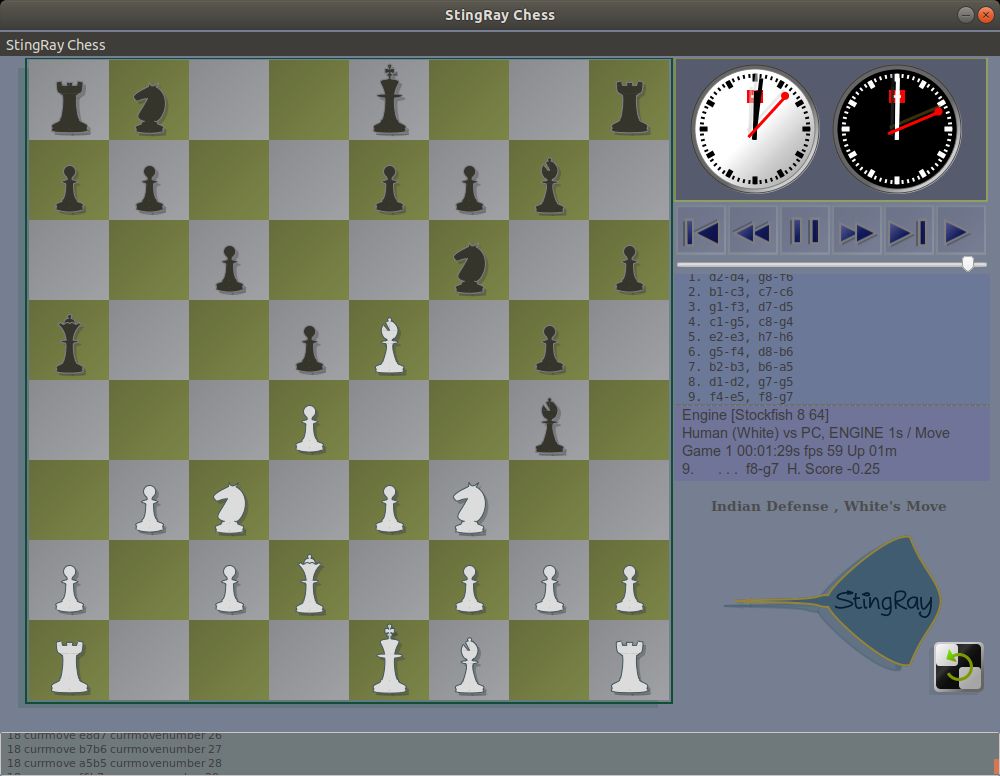
I’m not a fan of the default chess pieces. They are too spindly for my liking. Fortunately, there’s a ‘fat’ piece set which has a professional appearance. You can customize the colour scheme too. Here’s an image with the light purple colour scheme with fat pieces.
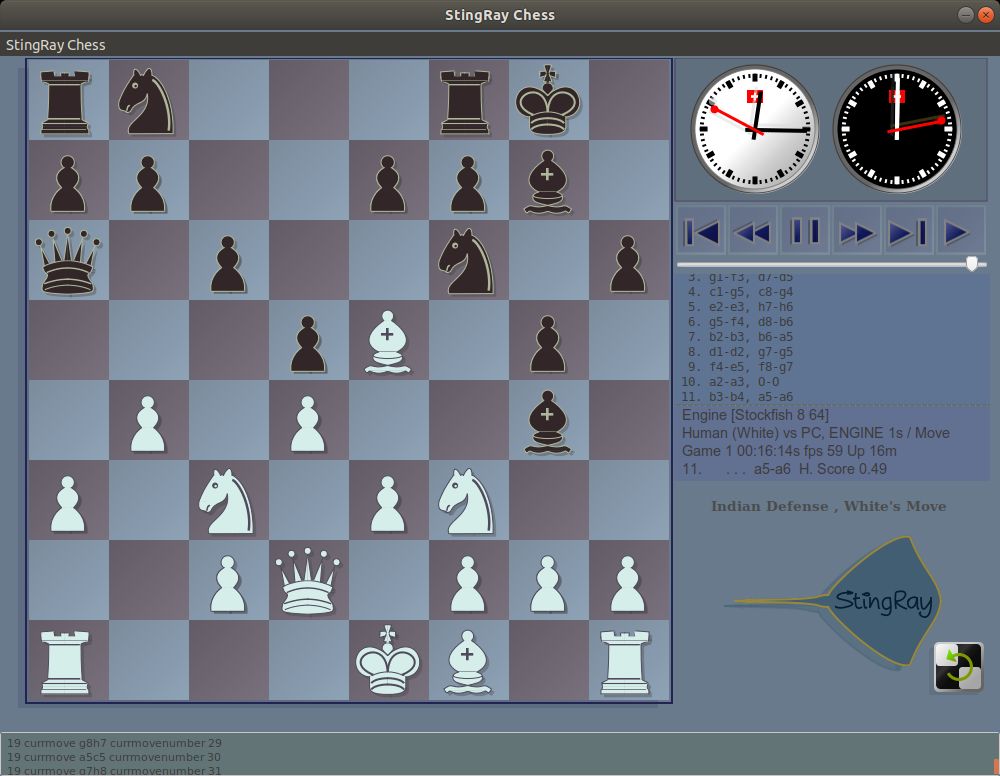
There’s lots of nice touches in the software. The demo mode showing classic games makes for a good demonstration of the client. And there’s plenty of configuration options for those who like to tweak their software.
Asus Tinker Board S
There’s also support for Raspberry Pi devices with a 32-bit Debian package. This package installs successfully on other ARMv7 architectures such as the Tinker Board S. Here’s an image of StingRay in action on the Tinker Board S. It’s a real pleasure playing chess on this wee device.
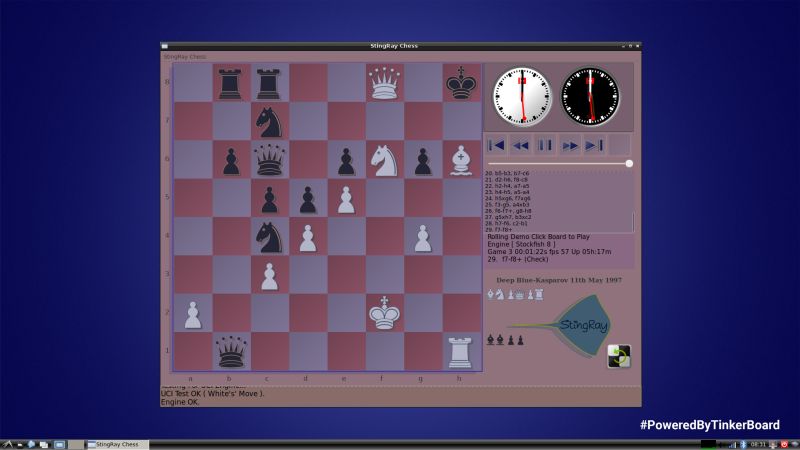
And if you’re curious to see the system resources consumed by StingRay on the Tinker Board S, here’s top with StingRay using the Stockfish chess engine. As you can see, StingRay’s memory and processor consumption is frugal.
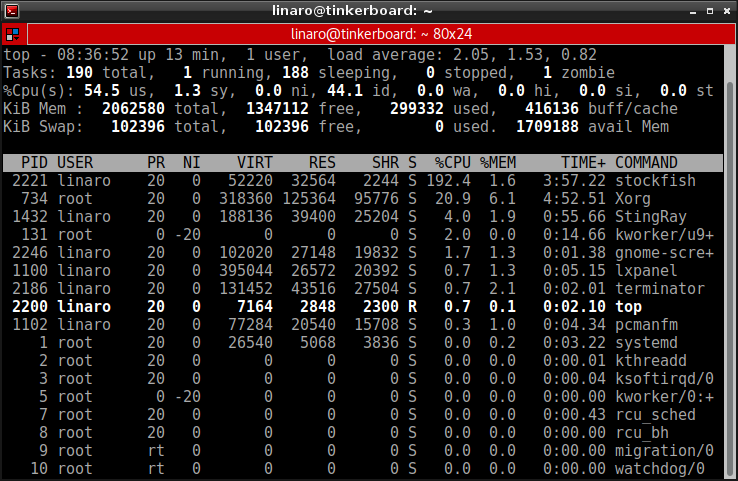
Let us know how StingRay runs on a Raspberry Pi device in the comments section below!
There are a few improvements I’d love to see in the GUI.
The Info box needs refinement. In its current state I had to turn it off. The Info box is the grey portion at the bottom of the images. It scrolls at such rapidity you cannot read the output (which is analysis from the chess engine). I found the scrolling too much of a distraction when playing a game.
What else could be improved? I’d prefer the menu bar to be more standard fare. Everything comes one down from a single menu. If you like digital clocks, you’ll also miss them.
The game supports UCI and XBoard protocols, so there’s tons of chess engines you can play against. Selecting the chess engine in the GUI could be streamlined. Currently, you’re presented with a dialog box showing software in /usr/bin/. Of course, there’s lots of non-chess engines in that directory. In one session, I accidentally selected xboard as the engine. This forced me to delete the config file, as xboard kept starting up. I’d prefer a simple list showing the engines which are (and are not) currently installed on a user’s system.
There’s a bug using the latest stable release of Crafty (25.2) which materializes when you try to restart a game. But the developer is fixing that (minor) issue which doesn’t affect any other release of Crafty or chess engine.
Features:
- Save and load games.
- Supports UCI / XBoard protocols.
- Supports PGN format.
- Easy to use GUI, basic functionality.
- Limited CPU / memory requirements. The software is designed to run on Raspberry Pis.
- Supports FEN setup, ponder, time controls, ply (depth) controls, Blitz, infinite time etc.
- Tablebases – uses Syzygy or Nailmov tablebases.
- Demo mode (engine vs itself) and rolling demo of classic games.
- Various colour schemes – Sky, Blue, Lavender, Blue-Grey, Granite, Gold, Emerald, Purple, Red-Green, Pink, Palm-Green, and Light Purple.
- Board size – big, medium, small, tiny, and micro, together with a full screen mode. The GUI occupies the full screen using TinkerOS (the Debian based distribution used by the Asus Tinker Board S), but not in Ubuntu or Manjaro.
Summary
If you’re looking for a simple way to play chess on your computer, StingRay offers a pleasant and lightweight GUI. It’s deliberately frugal on features and system resources, but still provides the essential basics. There’s no support for internet chess servers, but what StingRay does, it does well. Give it a download.
It’s a shame the source code is unavailable. For the best open source chess software, visit our dedicated feature.
Website: stingraychess.org
Support: FAQ
Developer: Sean Burberry
License: Proprietary
StingRay is written in C. Learn C with our recommended free books and free tutorials.
I’ve already given Sean, the game’s developer, my feedback. He’s responded very positively. Download the software from the website above, and share your feedback.
Version tested: 0.98g beta
UPDATE:
Literally as we published the review, the developer has released a new version taking into account my feedback on version 0.98g. In the new release, 0.98h, the Info box no longer scrolls, the chess board uses the fat pieces by default, and the menu has been revamped. The crafty bug appears fixed too.
It doesn’t appear that opening books nor tablebases are working correctly in the new release.
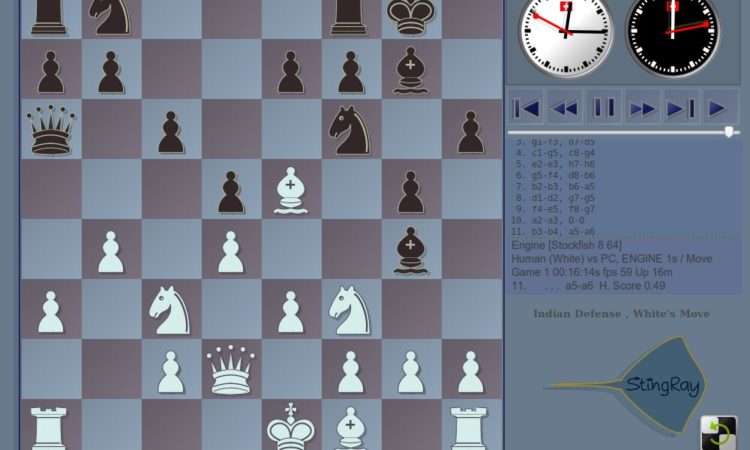
This software is missing lots of essential features (at least for me). There’s much better open source chess GUIs available. Without the source code being published, this software will never garnish attention among the chess playing community.
Avoid this software like the plague!!!
FAQ says
This version ( i.e. version 0.98h and earlier ) is free. There may be non-free versions in the future.
Dragging pieces on a Raspberry Pi is not quite there. It’s better clicking the pieces.
On my main PC, piece movement is fine. The chess book doesn’t work, it just ignores and uses crafty’s built-in very limited chess openings.
Given that xboard has so much more functionality and it’s open source, I’m not going to change my GUI any time soon.
Some people seem to think that you can’t have commercial open source software. But just look on Wikipedia – there’s a big list of open source software where the developers charge money. Personally, I try to avoid proprietary software wherever possible. At least with open source software, if the developer walks away from the project, there’s the possibility that someone else will take it on. There’s nothing worse than spending a lot of time learning how to use software, and then down the line find it abandoned with no possibility of resurrection.
ROTFL